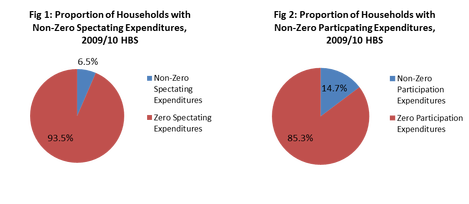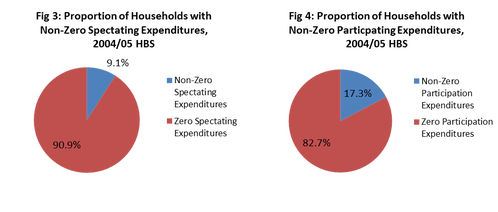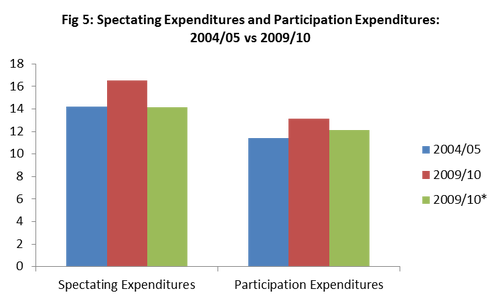The first thing to note is that not all households spend money on spectator sports and sports participation. For many households, sports related purchases do not comprise part of their normal basket of goods (and many households spend on sports related items, i.e. subscriptions to sports clubs, which are not considered here). Figures 1 and 2 show the percentage of households (as a proportion of the overall sample surveyed) with positive spectator expenditures and positive participation expenditures.
important factors. Figure 5 compares the average level of spend by Irish households on these two goods (based on using positive expenditure values only).
The changes in the volume of sports expenditures have to be looked at in the context of changes in the overall levels of total household expenditure. Between 2004/05 and 2009/05, average total weekly household expenditures increased by 3% but with inflation running at approximately 7% during the period, the real change was in fact a decrease of 4%. Therefore it appears that the decrease in the volume of household consumption over the 2004/05 to 2009/10 period is hitting spectating expenditures harder relative to participation expenditures. Using economics jargon, we say that spectating expenditures are more income elastic relative to participation expenditures. Participation expenditures on the other hand are probably influenced to a greater extent by qualitative factors such as the age profile and family composition of the household. These variables may help to explain why proportionally fewer households are spending money on sports participation but the overall volume of spending is still increasing. For example we may have a relatively older population now compared to a number of years ago (so participation rates fall) but the younger age groups now are spending more (so spending on average increases). Further discussion of the
effect of these variables on sports purchases will be the subject of my next blog.



 RSS Feed
RSS Feed